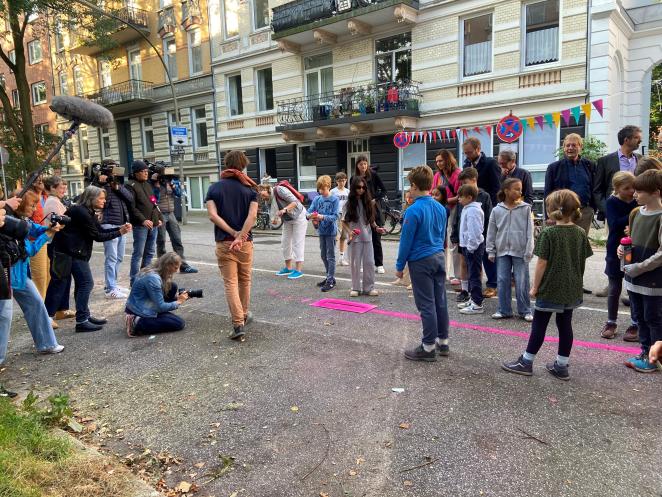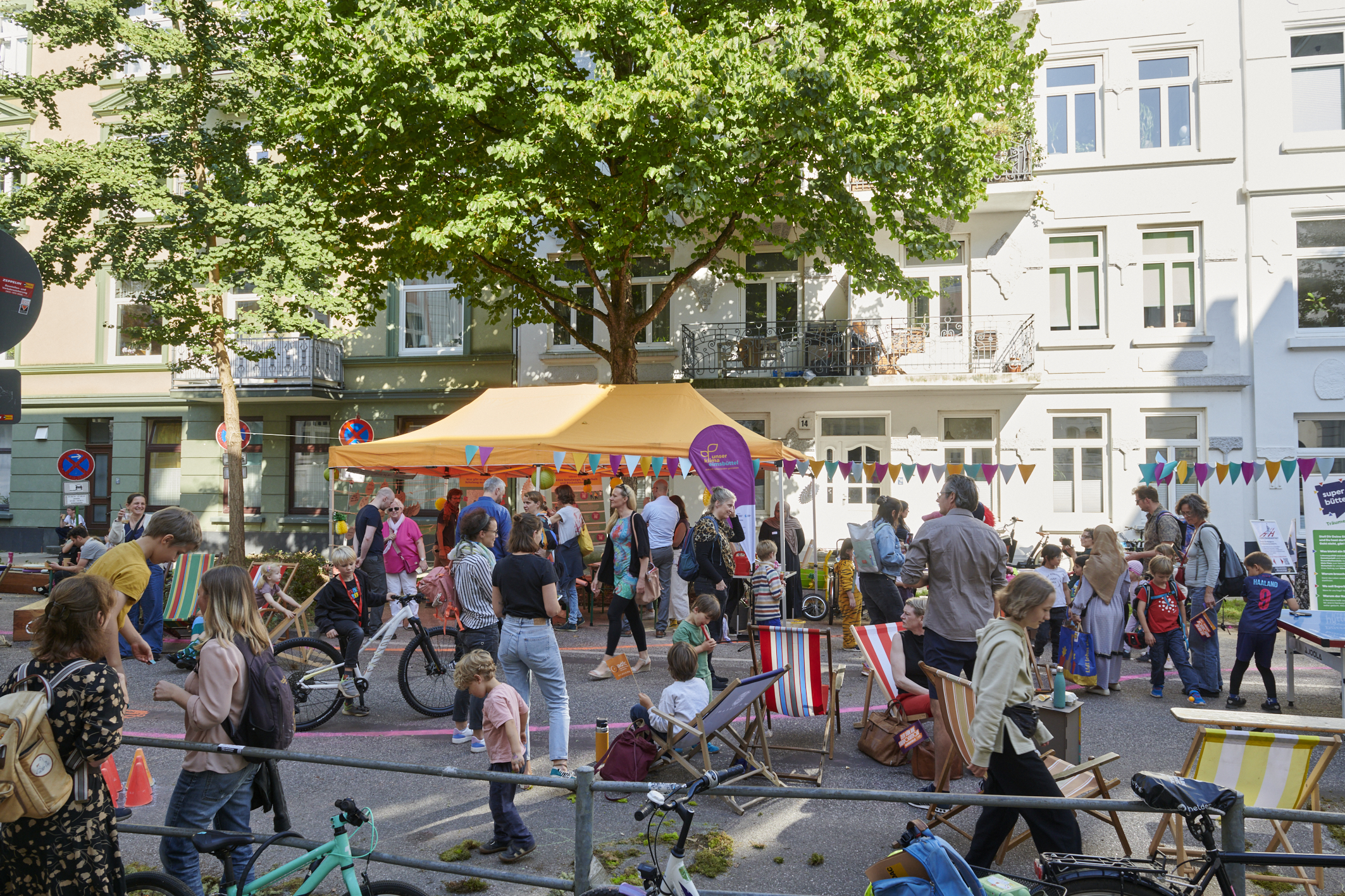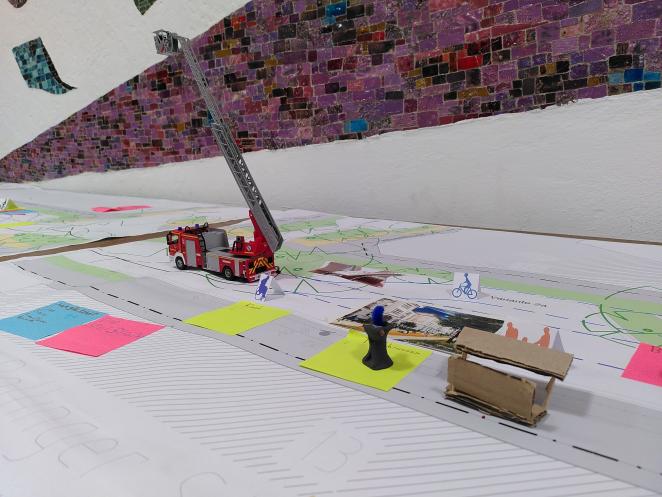The Hamburg borough of Eimsbuettel, one of the city's seven districts, has joined the Active Cities project with a pilot focusing on active mobility in areas surrounding schools, and child-oriented street design. The pilot site, a street section in front of the elementary school Rellinger Straße, is situated in a dense urban area in the heart of Eimsbuettel. As in many other areas, the street space is mainly taken up by parked cars. Crossing the street is confusing and difficult for children, and parental taxis lead to further dangers.
In this article, the Hamburg-Eimsbuettel team will share some insights from the co-creation process of re-designing the street.
Written by Silke Edelhoff, Maren Derneden, Yana Dinkelmeyer
Cover photo credit Angelika Pohl
Whether children (and their parents) choose active means of transport to get to school or extra-curricular activities is a question of infrastructural circumstance: Are there safe routes to school for (young) cyclists and pedestrians? Is there enough space for walking and cycling, especially during the morning rush hour before school? Can they safely cross the streets without any problems? It is important to address these issues, and to pay due attention to the needs and competencies of children navigating road traffic. At the same time, active mobility is also a question of mobility habits - It is crucial to learn how to be out and about on foot or by bike from an early age. Moving regularly in the fresh air is important for the healthy and social development of children.
The Eimsbuettel pilot works on this topic in two ways:
- Implementing an intense co-creation process to re-design a street section in front of a school,
- Working on safe school routes and incentivising active mobility on the way to school, working together with various stakeholders in the field of mobility and education.

© Maren Derneden
Based on ideas of a neighbourhood initiative, a school route survey by the parents' council, and a political decision, the district of Eimsbuettel started a planning and participation process in 2023 to re-design the surrounding of the school. In the long run, the whole street is supposed to be designed as a cycling route. With its focus on pedestrian and bicycle traffic as well as space for neighbourhood activities, the pilot project is supposed to be a model for active and climate-friendly school mobility in Hamburg and other cities. Furthermore, the pilot deals with the question of how to reduce the number of kids commuting to school by car and to enhance active school mobility by participation and incentives for behaviour change.
In the course of the project, a multi-stage participation process was initiated, supported by external facilitators. The aim was to involve school kids and staff as well as the neighbourhood and further interested parties and provide the opportunity to bring in their ideas and concerns. The process started with an informational event in July 2023. In the end of 2023, the co-creational design process was started, supported by external experts. An `Idea Kit` with child-oriented information, questions and creative material was provided to all learners. As a result, the main issues for the kids and some creative ideas were collected. This first phase of the design process revealed what is important for the kids: playing, relaxing, moving, green spaces and a colourful design. In the frame of an idea workshop in February 2024 the kids and later on the neighbourhood developed these ideas further and discussed different variants of the cycling route. In June 2024 two possible designs of the commissioned landscape architects were discussed by kids and neighbourhood in two seperate workshops. The vote of the school kids and the adults were similar: most oft he participants preferred a rather green design. But the kids also stated that a colourful design and opportunities to play were important for them, too.
The whole process was, and still is, accompanied by the Neighbourhood Spaces Eimsbuettel Newsletter, which provides up-to-date information on the project. The project website is another useful resource to stay informed on progress and developments.

© Giuliani von Giese
In September 2024, Rellinger Straße became the focal point for the European Mobility Week and Walking to School campaigns. Under the title of Movement and Encounters, the area in front of the school was used throughout the day for activities on the topics of safe routes to school and human-centric street design.

© District of Eimsbuettel
In the morning, activities for the children of the Rellinger Straße School were offered as part of the school authority's Walking to School campaign weeks. Transport Senator Anjes Tjarks gave the starting signal. At the same time, the children were invited by the district of Eimsbüttel to bring the redesign of Rellinger Straße onto the street. With the help of road marking paint, the planned cycle traffic routing was brought to scale on the road. This also outlined the plans for the new open spaces and made them tangible.
In the afternoon, the school and neighbourhood were invited to try out some of the morning's activities, get creative or make themselves comfortable with coffee and cake. Whether it was a cargo bike test, making seed bombs, information about active mobility or a relaxed coffee on the street - a varied program was offered. The district of Eimsbüttel and Naumann Landschaft presented the status of traffic and open space planning for the area in front of the school, while there were also other information stands, on the topics including activation and information on routes to school.
In the following months, the planning was finalised and coordinated with public authorities. In the beginning of 2025, the legal process of changing the usability of the street was initiated. Right now, the implementation planning is finalised to prepare the necessary procurement procedures for the implementation in summer. And when the kids get back to school after their holidays, they will find a newly designed street section, with possibilities to play and stay, a safe cycling route and green spaces – provided everything goes according to the plan. Until then, a visualisation anticipates the new design.
When the new design is implemented, the team will reflect on an intense process of planning and co-creation – with enthusiastic kids and neighbours as well as sharp criticism (that has decreased, but not completely vanished in the course of the project), intense coordination with public authorities, difficult questions to solve – from the drainage and the accessibility for fire brigades to the question of whether to replace one tree in order to get an optimum design for the street. The intense participatory process involving kids as well as the neighbourhood, the day of action and the close collaboration between traffic and landscape planning are some of the most important keys to viable solutions. How the solutions work in practice will be shown in an evaluation.
The process has taken a lot of time and resources – but the team are optimistic that learnings from this project will benefit them when implementing further projects in school surroundings.

© Nauman Landschaft.
